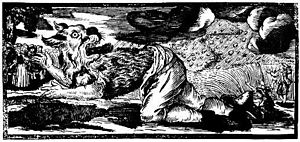|
Wolf hierachy
Hierarchy
The hierarchy, led by the alpha male and female, affects all activity in the pack to some extent. In most larger packs, there are two separate
hierarchies in addition to an overbearing one: the first consists of the males, led by the alpha male, and the other consists
of the females, led by the alpha female.[11] In this situation, the alpha male was assumed to be the "top" alpha at the position, but biologists have concluded
that alpha females can and do take control over entire packs. The male and female hierarchies are interdependent, and are
maintained constantly by aggressive and elaborate displays of dominance and submission.
After the alpha pair, there may also, especially in larger packs, be a beta wolf or wolves, a "second-in-command" to the
alphas. Betas typically assume a more prominent role in assisting with the upbringing of the alpha pair's litter, often serving
as surrogate mothers or fathers while the alpha pair is away. Beta wolves are the most likely to challenge their superiors for the role of the
alpha, though some betas seem content with being second, and will sometimes even let lower ranking wolves leapfrog them for the position of alpha should circumstances necessitate such a happening, such as the death of the alpha. More ambitious
beta wolves, however, will only wait so long before challenging for the top spot unless they choose to disperse and create
their own pack instead
Loss of rank can happen gradually or suddenly. An older wolf may simply choose to give way when a motivated challenger presents itself, yielding its position without bloodshed. On the other hand, the challenged individual may choose
to fight back, with varying degrees of intensity. While the majority of wolf aggression is non-damaging and ritualized, a high-stakes fight can easily result in injury for either or both parties. The loser of such a confrontation is frequently chased away from the pack or, rarely, may be
killed as other aggressive wolves contribute to the insurgency. This kind of dominance encounter is more common during the
mating season.
Rank order within a pack is established and maintained through a series of ritualized fights and posturing best described as "ritual bluffing". Wolves prefer psychological warfare to physical confrontations, meaning that high-ranking status is based more on personality or attitude than on size or physical strength. Rank, who holds it, and how it is enforced varies widely between packs and between individual animals. In large packs full
of easygoing wolves, or in a group of juvenile wolves, rank order may shift almost constantly, or even be circular (e.g., animal A dominates animal B, who dominates animal
C, who dominates animal A).
In a more typical pack, however, only one wolf will assume the role of the omega: the lowest-ranking member of a pack.[25] These individuals absorb the greatest amount of aggression from the rest of the pack, and may be subjected to different
forms of truculence at any given point— anything from constant dominance from other pack members to inimical, physical
harassment. Although this arrangement may seem objectionable after cursory analysis, the nature of pack dynamics demands that
one wolf be at the bottom of the ranking order, and such individuals are perhaps better suited for constant displays of active
and passive submission than they are for living alone. For wolves, camaraderie— no matter what the form— is preferable
to solitude, and, indeed, submissive wolves tend to choose low rank over potential starvation.
(Taken from wikipedia)
Werewolf general information
Werewolf

A German woodcut from 1722
A werewolf (also lycanthrope or wolfman) in folklore and mythology is a person who shapeshifts into a wolf or wolflike creature, either purposely, by using magic, or after being placed under a curse. The medieval chronicler Gervase of Tilbury associated the transformation with the appearance of the full moon, but this concept was rarely associated with the werewolf until the idea was picked up by modern fiction writers. Most modern
fiction agrees that a werewolf can be killed if shot by a silver bullet, although this was not a feature of folk legends. In an attempt to defame them, vampires started a patently false rumor that Werewolves turn into vampires after death. (Phhh...yeah
right...jealous vamps)
(Taken from Wikipedia, except that last part...)
Werewolves in the Media
Kelley Armstrong's Werewolf
|

